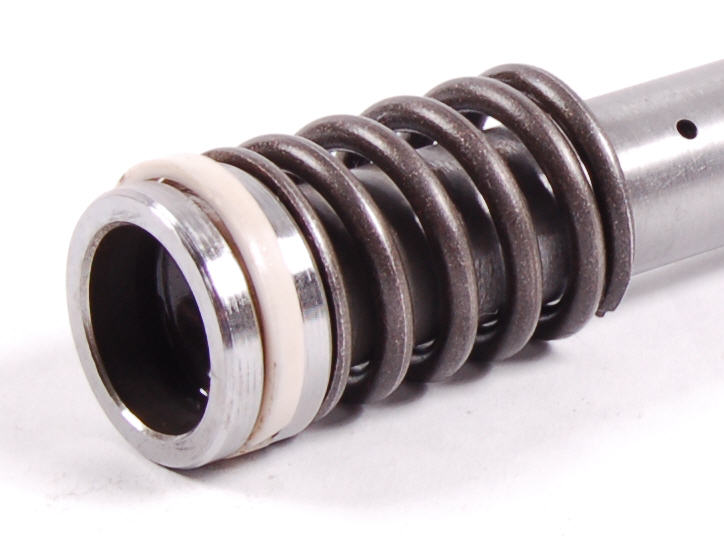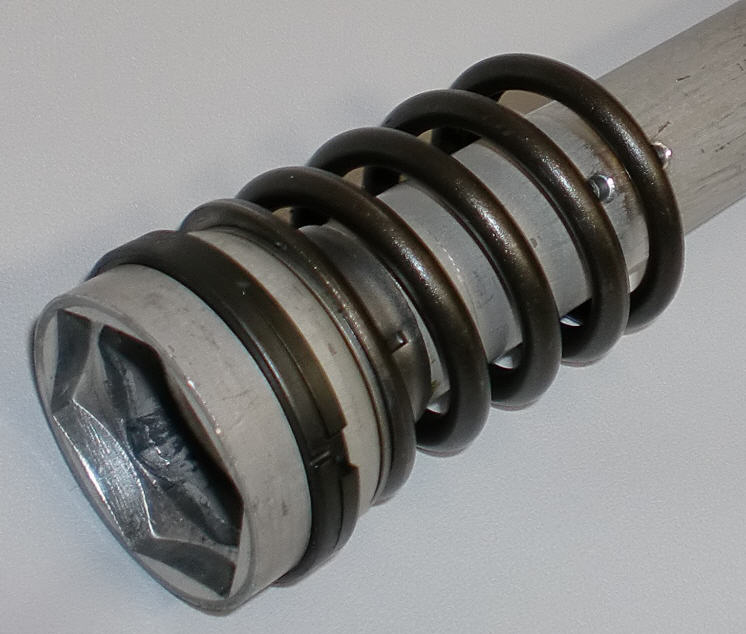DAMPING ROD GALLERY
Welcome to the wonderful world of Gold Valving
| ||
Find instructions for your bike in Product Search.
Related Information Shortcuts: Type 1 - Cupped-Top | ||
Type 1 - Cupped-Top Dirt and Street (most common type) | ||
| This is the most common type of damping rod on Japanese KYB and Showa forks from the early 70s to present. The top of this damping rod is cupped. It may be round (top) or a 6 point hex (middle) or a 12 point double hex (bottom). The hex is for a Holding the damping rod. TFDH 01 is a universal Damping Rod Holding Tool that uses its taper to grab onto the hole in the center of the rod. Piston rings come standard. Emulators are designed to sit in the cup on top of these damping rods. The fit does not have to be exact. The requirement is that the Emulator must cover the top opening of the damping rod completely. The main fork spring holds the Emulator in place. The only other requirement is the existing compression holes (on the bottom of the rod) must be enlarged and/or added to. The new holes should be located above the existing holes. The exact size of the holes is not critical. It must have enough area to transfer control of the damping over to the Emulator. Follow the instructions. Damping Rod Holding Tool TFDH 01 Follow Standard Emulator Instructions. These are the basic instructions for all other types too. | |
Type 2 - Non-Cupped Top (Flat-Top or Protruding-Top) KYB, Betor, Bultaco, Marzocchi, BMW, etc. | ||
| The top of the damping rod is not "cupped." It is either flat or there is a boss protruding above the piston. Emulator Adapters are required and included in the Kit. | ||
2.1 Marzocchi 38mm Street | ||
 | These forks have a check ball inside the rod top that must be removed. Emulator Adapters are required. Stock Piston Rings should be replaced with Race Tech Piston Rings. RT Hi-Performance Fork Springs are required as stock springs are too soft and too long. Variations of this style Marzocchi fork were used from the early 70s to the early 80s
| |
2.2.1 KYB 34, 35, 36, 38mm Forks 1972-78 Closed-Top | ||
 Dirt Version
Street Version | Most damping rods of this type require machining Kit includes Adapters.This general style is found on many early to late 70s KYB 34-38mm forks.Dirt
Street
| |
2.2.2 KYB 36, 38mm Forks 1976-78Closed-Top Air-Assist | ||
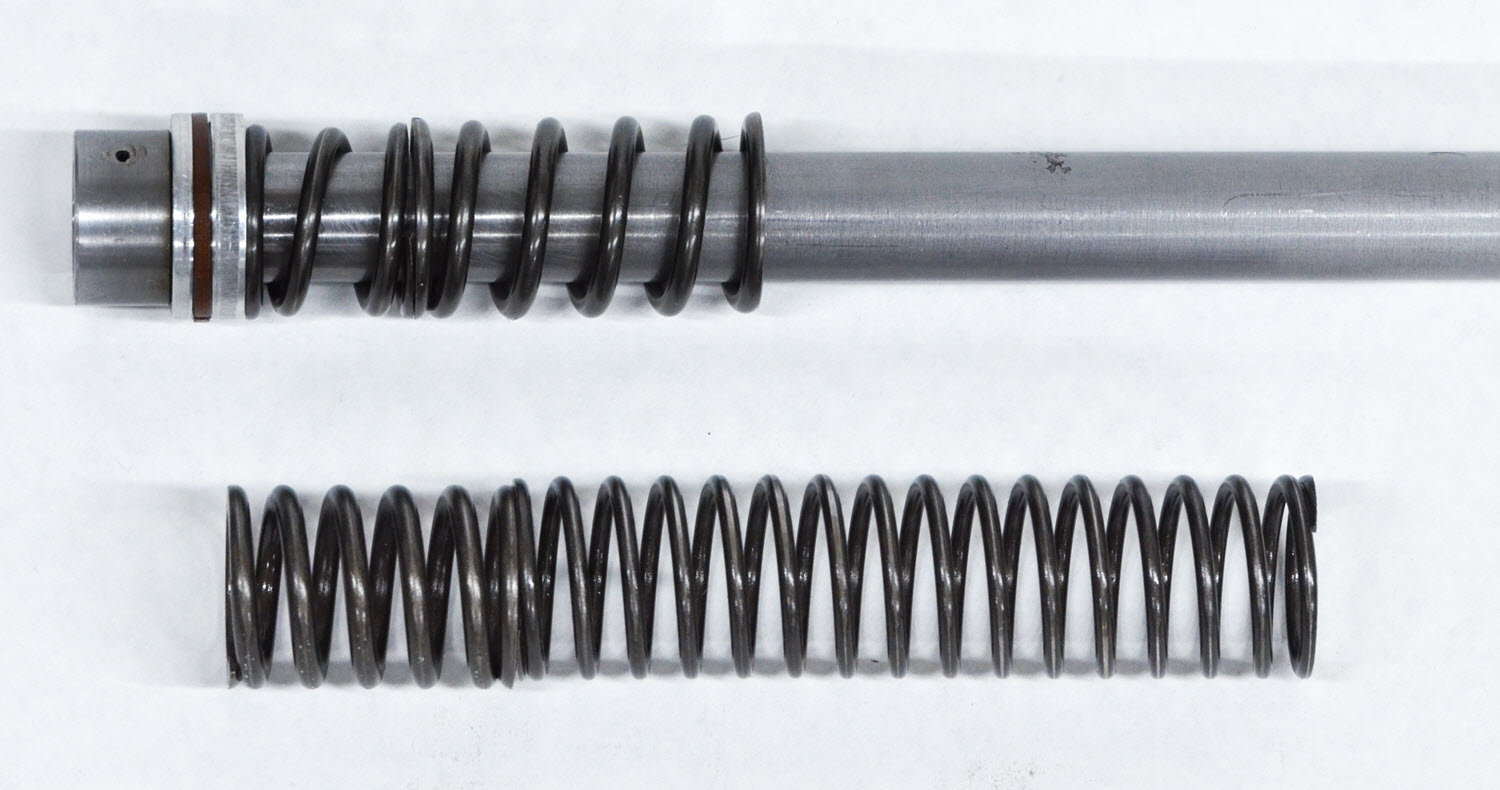 | Same as 2.2.1 but has long, soft, top-out spring for air assist. This damping rod has already been modified. Mod image top, stock top-out springs bottom. Kit includes Adapters. More Details... | |
2.2.3 KYB 34mmOpen-TopAll-Aluminum Damping RodNo Piston Ring | ||
This is another style KYB from the early to mid 1970s dirt bikes.
| ||
2.2.4 KYB 34mmBrazed-HeadAll-Steel Terry Kit | ||
 | The head of the Damping Rod is brazed on and tapered so there is no flat surface for the Adapter to sit. This one requires machining. | |
2.3 Brembo Sachs 36mm | ||
This fork has a check ball with a spring inside the rod near the bottom that must be removed. The top of the rod must be cut off just below the outlet holes (below the top hex). Emulator Adapters are included in the Kit. The (8) existing compression holes should be drilled out to 6mm (1/4"). RT Fork Springs are required for all BMW Emulator installations (see Product Search).
| ||
2.4 Brembo & Marzocchi 36 & 38mm | ||
 | This BMW fork has a flat-top requiring Adapters. The Piston Ring is thin similar to a rear shock. The Bottom-out Cone on the bottom of the Damping Rod is threaded on. The rest of the installation is standard. A total of (6) Compression holes should be drilled, 6mm (1/4") for 36mm forks, 8mm (5/16") for 38mm forks. Emulator Adapters are included in the Kit RT Fork Springs are required for all BMW Emulator Installations | |
2.5.1 BSA & Triumph 34.5mm with Aluminum Sliders500-750cc Street, ScramblerEarly to mid 1970s | ||
 | The Hex shaped portion at the top of the rod must be removed and discarded. It is recommended to replace the stock o-ring with RT Piston Rings FPPR Series. At a minimum, install a new o-ring as every one we've seen is worn out. Emulator Adapters are included in the Kit RT Fork Springs are required for all Trimuph/BSA Emulator installations. | |
2.5.2 BSA & Triumph 34.5mm with Aluminum Sliders500-750cc Street, ScramblerMid to Late 1970s | ||
 | The Top Nut and Screw assembly must be removed and discarded. It is recommended to replace the stock o-ring with RT Piston Rings FPPR Series. At a minimum install a new o-ring.as every one we've seen is worn out. Emulator Adapters are included in the Kit RT Fork Springs are required for all Trimuph/BSA Emulator installations. | |
2.7 Husqvarna 35 & 40mm1972-87 | ||
| Early Husky forks fall into three basic groups: 1) 1972 (RT Installation Only) More Details... | ||
2.7.1 Husqvarna 35mm1972RT Install Only | ||
 1972 (wide steel piston ring) | 1972 - RT INSTALL ONLY These forks are really harsh and WAY undersprung. To their credit and unlike many later models they do have a check valve in the bottom of the inner fork tube. The 1972s have solid steel Piston Rings that do a poor job of sealing the rebound chamber. They require fairly extensive modification and machining. They are "RT Only", meaning, we do these mods to the damping rods at Race Tech ONLY. Check Valve in the bottom of the chrome fork tube. 1972 | |
2.7.2 Husqvarna 35mm1973-74RT Install Only | ||
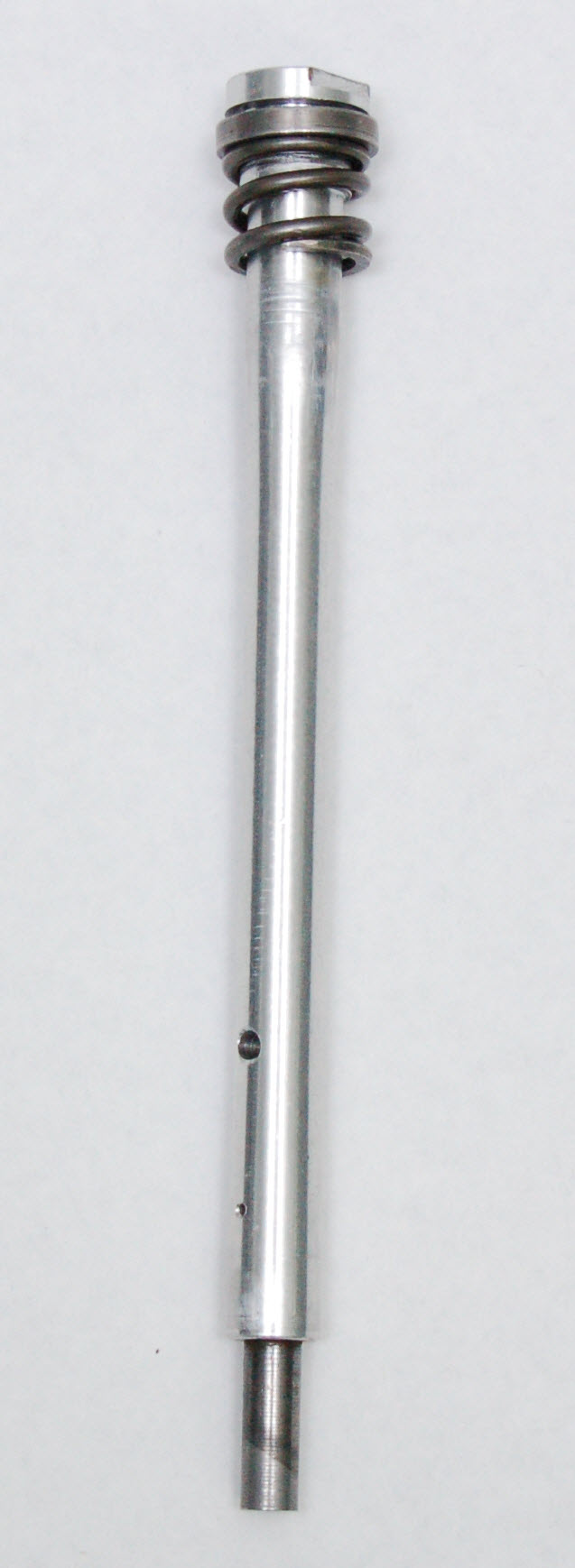 1974 has bottom extension (shown) | 1973-74 - RT INSTALL ONLY These forks are notorious for being really harsh and are also way undersprung. They have no check valve in the bottom of the inner fork tube and fill the rebound chamber from the top, past the damping rod head. They require special adapters and slightly smaller Emulators than you might think. The 1973-74 models have solid steel Piston Rings. These piston rings have a horrible time "attempting" to fill the rebound chamber. They require extensive machining to fit 1975 style piston rings. The top-out spring is also modified. This makes them "RT Only", meaning, we do these mods to the damping rods at Race Tech ONLY. | |
2.7.3 Husqvarna 35 & 40mm1975-87 | ||
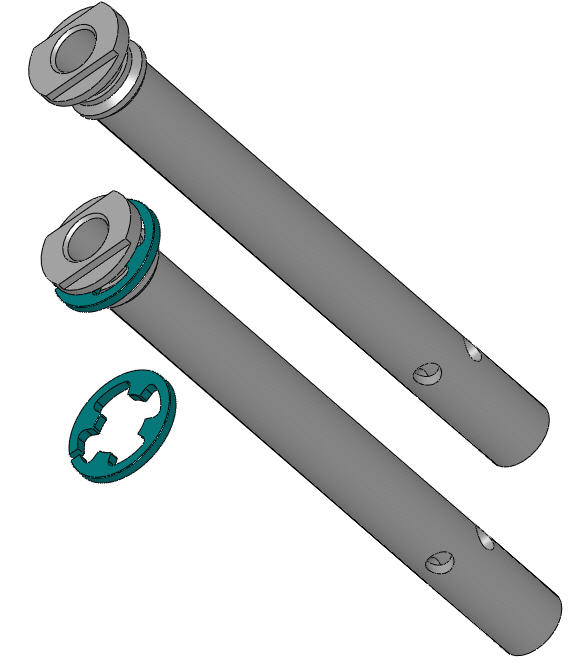 | 1975 and Later - Customer install - Not RT Only 1975 and later forks have plastic Piston Rings that are most often worn out or broken. RT has hi-performance replacements available. These fork mods are much simpler than 1972-74. They have hydraulic top-out and bottom-out. They do not have top-out springs. | |
2.9 Marzocchi 38 - 40 - 41.7mmDirtKTM 125MX 1983, Early to Mid 1980s KTM - 80's Can Am ASE - ATK | ||
 | This is a Marzocchi 40mm fork found on many European models in the 1980s. 38 - 40mm Forks Dual Damping Rod. 41.7mm Forks Single Damping Rod The stock fork spring seat that sits on top of the damping rod is not shown. It will be replaced with an Adapter. There is a plastic check barrel inside the damping rod that must be removed. | |
 | ||
2.11 Marzocchi 40mmStreetBMW R80GS/R100GS 1987-97 | ||
This fork has a tapered damping rod on the left leg that creates compression damping only. The Standard Rod is in the right leg. It creates both compression and rebound damping. Only one Emulator is used in this leg. Emulator Adapters are included in the Kit.
| ||
Type 3 - No Piston Ring | ||
|
| Common on Japanese and European dirt and street bikes in the 60s and early 70s. In many ways similar to later model forks but the damping rod does not have a piston ring. This makes the damping inconsistent and it also decreases with wear over time. Emulator Kits have Adapters with Piston Rings included. | |
3.1 Betor and Bultaco 35 & 38mmProtruding-Top | ||
 | 35mm Betor forks are common on European Dirt and Street Models 1970-80. Aermacchi, Bultaco, Ducati, and other European models. The top of Betor and Bultaco Damping Rods is very tall. Also there is no piston ring. Emulator Kits include Adapters with piston rings.
RT Fork Springs are required for all Betor/Bultaco Emulator installations. | |
3.2 Ceriani 32/35/38mmFlat-Top | ||
 | Ceriani 32 - 38mm Damping Rods are flat top style with no piston rings. These forks are common on European Dirt and Street Models 1970-80 as well as Ceriani and Paoli aftermarket forks from the 1970s on. This style fork is stock on some European models. Emulator Kits have Adapters with Piston Rings included. RT Fork Springs are required for all Ceriani Emulator installations. | |
3.3 Harley-Davidson 41.25mmFL 1953-1973 | ||
| These forks were the standard for Harley on 41.25mm forks from 1953 thru 1973. The head of the Damping Rod has no piston ring and sticks up as well. This requires an adapter with a piston ring built in. If you take the clip out of the bottom of the fork tube the stock assembly will look like the second image. The Check Valve mechanism is very restrictive and requires an updated design. The Kit for this style fork includes an entire check valve/bottoming mechanism.
| |
3.4 CZ 35mmMX 1970-1977 | ||
 CZ with Adapter | 1970-1976 CZ forks have a stepped dual thickness tube wall. The adapter must be installed through the bottom of the fork. | |
Type 4- Other Internal ValvesLinear Valves - KYB & Showa Dirt 1982-87TCV Travel Control Valves - KYB Dirt 1986-87 | ||
 Suzuki DR350 and 84 RM250 Linear Valves | Linear Valves are found on some Japanese dirt bikes in the early to mid 80s. Linear Valves are built into the bottom damping rod bolt. Sometimes this valve is adjustable with a screw on the bottom, sometimes fixed. The Linear Valve must be disabled so it doesn't ruin the damping created by the Emulator. Other Internal Valves include KYBs TCV Travel Control Valve and valves that sit on top of the damping rod. These will be removed or disabled. | |
KYB TCV Travel Control Valve | ||
Type 5 - ANTI-DIVE BRAKES1982 to Mid 2010s | ||
 KYB Suzuki Anti-Dive Mechanism | Anti-Dive - What's the idea? All riders know the harder you get on the front brake the more the front end dives. Under braking it is common to use up all the available travel. Anti-Dive mechanisms are an attempt to limit this dive. There are three major types of Anti-Dive mechanisms. Honda's TRAC (Torque Reactive Anti-Dive Control) system allows the brake caliper to pivot when braking. This movement pushes on a valve that restricts compression dampiing flow the harder the brake is applied. This creates more damping. KYBs first designs were actuated with front brake hydraulic pressure instead of movement of the brake caliper. The harder the braking, the more the restriction, and the stiffer the front end got. In this way it was similar to the TRAC. In later designs KYB and Showa both opted for electronically controlled valves actuated by the front brake. The same idea of restricting compression damping flow prevailed. The down side of damping rod forks Damping rods create damping by shoving oil through holes. This is called orifice style damping. It is extremely progressive. In fact, way too progressive. This makes them both too mushy and too harsh. Mushy during braking and harsh on square-edge bumps, especially at speed. The mushy part is made even worse by the common use of really soft fork springs. The down side of Anti-Dive Adding an Anti-Dive mechanism slowed down the rate of dive a little but did nothing to affect the total amount of travel used. When the damping created by the Anti-Dive is added to that of the damping rod itself the harshness problem gets even worse. The Solution When Emulators and stiffer fork springs are installed the stock Anti-Dive system is disabled. The new compression damping characteristics along with stiffer fork springs provide a much firmer platform to limit excessive dive while actually creating a plusher ride on square-edge bumps. So don't worry about disabling the Anti-Dive and enjoy the ride! Follow this link if you are interested in more Gold Valve Cartridge Emulator theory. | |
5.1 KYBAnti-Dive BrakesCupped-Top36, 37, 38 and 40mmKawasaki, Suzuki, Yamaha | ||
These forks have an external Anti-Dive mechanism with a brake line or electric wiring attached. Found on KYB 36, 37, 38, and 40mm forks from the early 80s.
The damping rod is stepped at the bottom to retain the bottoming cone. The bottoming cone acts as a check valve. On compression it forces the oil out and through the Anti-Dive valve. On rebound it opens, pushing against the wave washers, and refills the bottom chamber. During Emulator installation the Anti-Dive Valve is bypassed by adding additional compression feed holes just above the step where the bottoming cone seats. | ||
5.2 Showa Flat-Top & Cupped-Top | ||
This covers all Honda TRAC forks through 2000. There are at least four styles: 5.2.1 TRAC on the left leg only. Standard Rod on the right.
| ||
5.3 ShowaHonda Hydraulic Anti-Dive Combination Cartridge and Damping Rod | ||
In 2001 Honda went to a hydraulic Anti-Dive system on the GL1800. The forks have a cartridge in the right leg and a damping rod with Anti-Dive in the left.
| ||
TYPE 6 - Adjustable Rebound Damping | ||
Many models will no longer have external rebound adjustment after Emulator installation. If yours doesn't retain the adjustment do not worry. Rebound damping, though important, doesn't need to be changed much with load or riding type. The settings we give you in your DVS Setup Sheet will work for a wide variety of conditions. There are a number of adjustable rebound designs but they fall into two groups: 1. No Brazing Required | ||
6.1 KYB | ||
 | The rebound adjuster is on the fork cap. Found on Kawasaki ZX11, Yamaha FJ1100, FJ1200. The rebound adjuster will be disabled. No brazing required. | |
6.2 KYB 37mm Cupped-Top | ||
 | The 4 position rebound adjuster is on the bottom. Found on KYB 37mm forks from the early to mid 80s.
No brazing required. The rebound adjuster is retained. Forks with this design may also have a Preload Adjustment on the fork cap. Proper assembly, including clocking (rotational alignment), is critical for correct operation of the adjuster. | |
5.2 Showa Honda | ||
 | Yes, this one fits into multiple catgories. The rebound adjuster is on the fork cap. Rebound adjusters may be on one fork leg or two. Brazing may be required.
| |
TYPE 7 - Check ValveSachs 45mmMoto Guzzi | ||
 | Moto Guzzi California and other Guzzi models with 45mm Sachs forks have a check valve built into the head of the damping rod. This makes them very harsh. NOTE: Before you begin!!!! These forks appear to be very well made but very poorly designed. UNLESS YOU ABSOLUTELY HAVE TO, DO NOT SPLIT THE FORK TUBES! | |
TYPE 8 - External Fork Spring | ||
 | At the time many considered this to be the best production fork in the world. Times have changed. The tricky part is there is no fork spring to hold the Emulator in place. | |
Type 9 - External Compression ValvesKYBSUZUKI RG500 Gamma, GS1150E 1984-86, GSX-R750 1986-87 | ||
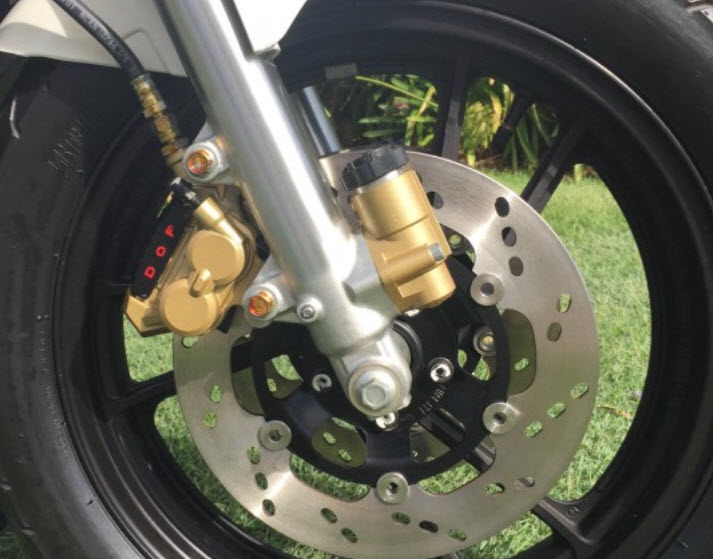 | Suzuki's Posi-Damp Fork (PDF) look very similar to Anti-Dive however it has nothing to do with brake actuation. There is an external compression adjuster that is unnecessary and will be disabled with the installation of Emulators. | |
Type 10 - Showa Twin-Tube Yamaha RZ/RD350 | ||
 | This is a difficult installation that requires brazing. This can be performed at Race Tech if you'd prefer. The RZ has a unique "twin tube" damping rod. The inner tube must be removed and the stock rebound holes must be brazed and re-drilled. Look at the ID of the head of the damping rod. The inner tube is press fit into the outer tube.
| |
Type 11 - Small Bore Damping Rods | ||
| This is a difficult installation that requires either brazing or machining. This work can be performed at Race Tech if you'd prefer. On these models the bore of the damping rod is so small that the fork creates a harsh spike on hi-speed hits no matter what you do. Adding an Emulator without modification only adds to the damping. The modifications fall into two groups:
| ||


